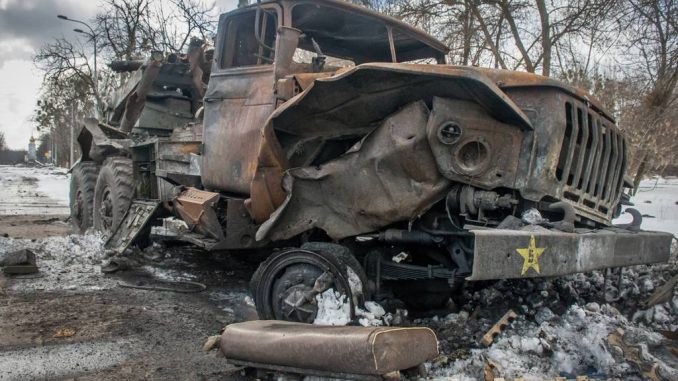
Members of Congress responded with near unanimity Wednesday in support of Ukrainian President Volodymyr Zelenskyy’s plea for more help in his country’s fight against Russia.
But exactly what that means for the United States and Ukrainian fighters is less clear.
Proposals to send more “defensive” weapons and humanitarian aid to the besieged European country appear to have strong backing from U.S. lawmakers, but requests for additional aircraft and a no-fly zone above the contested area remain divisive for members of Congress.
“We’re certainly open to doing whatever we can to help the Ukrainians stand up to Russia,” said Sen. Gary Peters, D-Michigan, chairman of the Senate Homeland Security Committee. “But I think we need to follow the advice of our military leaders as to what they think is appropriate and what could be effective.”
RELATED
:quality(70)/cloudfront-us-east-1.images.arcpublishing.com/mco/4X3HARYUD5EIBDEZON2I23GGPA.jpg)
In a video address to the U.S. Congress Wednesday morning, Zelenskyy praised the United States for its financial support thus far for Ukrainian forces currently fighting the invading Russian military to a standoff.
But, he added, the U.S. and its allies need to do more.
“This is a terror Europe has not seen for 80 years,” he said. “We are asking for an answer to this terror from the world. Is that a lot to ask?”
President Joe Biden provided a response to that just a few hours later, announcing that $800 million in new aid is heading to Ukraine in coming days. The package includes more anti-tank and anti-aircraft missiles, along with other equipment for ground forces fighting the significantly larger (and better equipped) Russian forces.
“These are direct transfers of equipment from our Department of Defense to the Ukrainian military, to help them as they fight against this invasion,” he said. “This new package on its own is going to provide unprecedented assistance to Ukraine.”
Biden said the aid includes about 800 new anti-aircraft systems, 9,000 new anti-armor systems, about 7,000 personal weapons and 20 million rounds of ammunition.
But U.S. president’s plan does not include facilitating the transfer of Polish MiG-29 aircraft to the Ukranians or enforcing a no-fly zone over Ukraine, two things that Zelenskyy specifically requested in his speech to Congress. Biden deflected questions on those issues at his press event on Wednesday.
Enforcing a no-fly zone remains a major concern for lawmakers, who on Wednesday repeatedly referenced Biden’s pledge not to allow U.S. troops to be drawn directly into the fighting. Most lawmakers avoided the topic in interviews following the speech.
But the transfer of the Polish planes has been a key point of friction between Republican lawmakers (and, in recent days, a growing number of Democrats) and the Pentagon.
Defense Department officials have said that helping prep and move the planes could be seen as an escalation of U.S. involvement in the war and would not provide a significant upgrade to Ukraine’s current aerial defense capabilities.
Earlier this week, the 58-member Bipartisan Problem Solvers Caucus (made up of 29 Democrats and 29 Republicans) urged Biden to ignore that advice, calling the aircraft transfer “a pragmatic solution to expeditiously provide the Ukrainians with aircraft that Ukrainian pilots have flown and their servicemembers can maintain.”
On Wednesday, House Minority Leader Kevin McCarthy, R-California, said the members would continue pushing to get the aircraft to Ukraine.
“It’s no different than us providing the javelins or other equipment,” he said. “The problem is the delay. The problem is this administration has delayed aid time and again, sending the wrong message.”
Several key congressional Republicans — including House Armed Services Committee ranking member Mike Rogers, R-Alabama, and Senate Armed Services Committee ranking member Jim Inhofe, R-Oklahoma — sent a letter to Defense Secretary Lloyd Austin on Tuesday asking him to “re-evaluate the flawed conclusion that the transfer of these fighter jets to Ukraine would be escalatory,” arguing the equipment is badly needed.
RELATED
:quality(70)/cloudfront-us-east-1.images.arcpublishing.com/mco/X2UHZRSEY5A2NO22TZS56UD7DA.jpg)
But congressional Democrats are divided on the issue.
en. Jeanne Shaheen, D-New Hampshire, the second-ranking Democrat on the Senate Armed Services Committee, recently called the White House opposition to the idea disappointing.
“It’s coming across as indecision and bickering among members of the administration, which is not helpful to the cause,” she said.
But Peters deferred to the Pentagon’s assessment on the planes when pressed Wednesday, and fellow Senate Armed Services Committee member Elizabeth Warren, D-Massachusetts, similarly deflected the issue.
“We can partly help protect that airspace with more defensive weapons,” she said. “The more that we put into that, both in terms of equipment and making sure that the Ukrainians are trained to use that equipment as effectively as possible, then the better protection you bring.”
House Armed Services Committee Chairman Adam Smith, D-Washington, in a statement said the United States “should continue to help the Ukrainians — offering humanitarian assistance, military aid, and more — while ensuring that Russia’s war in Ukraine does not widen.” He offered support for Biden’s moves thus far.
Biden said U.S. officials are sorting through U.S. stocks of military equipment to see if other assistance may be appropriate to send in the future. He promised the American aid to Ukraine would not end with this latest announcement.
“Let there be no doubt, no question, that America stands with the forces of freedom,” he said. “We always have and we always will.”
Leo covers Congress, Veterans Affairs and the White House for Military Times. He has covered Washington, D.C. since 2004, focusing on military personnel and veterans policies. His work has earned numerous honors, including a 2009 Polk award, a 2010 National Headliner Award, the IAVA Leadership in Journalism award and the VFW News Media award.



Be the first to comment